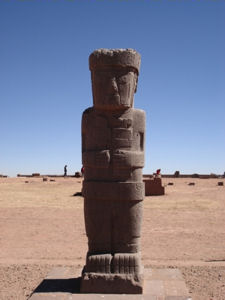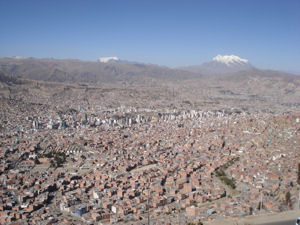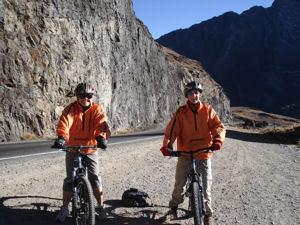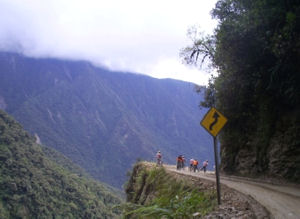Bolivia
Population: 8,990,000
Capital: La Paz
Time Zone: GMT -7
Part of 2006 World Trip, arriving from Peru and continuing on to Santiago and Buenos Aires .
A day to cycling the hair raising 'death road' and a few more to explore the La Paz Witches' market.
Use the navigation bar on the left or the map-links to select a place. Alternatively scroll down to see all the entries.Click on photos to enlarge. See all Bolivia photos here.
Tiahuanaco
 It was market day, and the border between Peru and Bolivia and it was manically busy; our tour driver, John, had to inch the truck through the streets, gesturing to the stallholders to shift their wares out of the road so we could pass. After the usual paperwork we cleared the border and were on our way again, heading to the ancient ruins of Tiahuanaco. Tiahuanaco was the base of the Tiwanaku empire, a major civilisation that predated the Inca. They were advanced for their time, developing some of the technologies often associated with the Inca era. The area now sits in desert and many of the ruins are still being excavated, but there is an extensive museum and some impressive statues. After a tour and some lunch, we continued on to La Paz, the highest city in the world.
It was market day, and the border between Peru and Bolivia and it was manically busy; our tour driver, John, had to inch the truck through the streets, gesturing to the stallholders to shift their wares out of the road so we could pass. After the usual paperwork we cleared the border and were on our way again, heading to the ancient ruins of Tiahuanaco. Tiahuanaco was the base of the Tiwanaku empire, a major civilisation that predated the Inca. They were advanced for their time, developing some of the technologies often associated with the Inca era. The area now sits in desert and many of the ruins are still being excavated, but there is an extensive museum and some impressive statues. After a tour and some lunch, we continued on to La Paz, the highest city in the world.
La Paz

We hit La Paz at an interesting time as it was the day before an important election, with the people voting on alterations to the constitution. All traffic was banned and shops were closed. Beer had also been banned from the previous night and the day was a public holiday. It was quite surreal wandering the silent streets where the day before streams of taxis and cars had been fighting for passage.
We only had a few days in the La Paz area so only had a quick look around the city on the first afternoon. The most notable place visited was the famous Witches Market, a place where you can buy anything from Lama foetus's to love potions and replica Inca statues, it was interesting but setup for tourism to a large extent today. The following day we headed off for a trip down the infamous death road.
Death Road
 Death Road is one of the major routes from La Paz to Brazil; and is a dirt road clinging to the edge of a mountainside, often with a shear drops of hundreds of metres. Being essentially single track, and with nothing to stop vehicle plunging into the jungle below, it leads to some difficulties as trucks and busses going in both directions try to negotiate the treacherous turns. It has a reputation as the most dangerous road in the world for a reason, and frequently along its length are plaques commemorating those who have perished. It is not because of the danger the road is a popular cycle route, but because it starts in the snowy high Andes at 4700m and plunges down more than 3 Km in altitude into the subtropical rainforests over a stretch of no more than 60 Km. The first section of this rollercoaster is on a sensible tarmac road, this makes the cycling easy but it did have some uphill sections, and at even easy assents feel pretty tough at this altitude. Pretty quickly the tarmac give way to a gravel road and the way becomes more winding.
Death Road is one of the major routes from La Paz to Brazil; and is a dirt road clinging to the edge of a mountainside, often with a shear drops of hundreds of metres. Being essentially single track, and with nothing to stop vehicle plunging into the jungle below, it leads to some difficulties as trucks and busses going in both directions try to negotiate the treacherous turns. It has a reputation as the most dangerous road in the world for a reason, and frequently along its length are plaques commemorating those who have perished. It is not because of the danger the road is a popular cycle route, but because it starts in the snowy high Andes at 4700m and plunges down more than 3 Km in altitude into the subtropical rainforests over a stretch of no more than 60 Km. The first section of this rollercoaster is on a sensible tarmac road, this makes the cycling easy but it did have some uphill sections, and at even easy assents feel pretty tough at this altitude. Pretty quickly the tarmac give way to a gravel road and the way becomes more winding.
 A couple of times I let myself gain some speed and entered a corner a little too fast, coming nearer than I like to the precipice of a road side. The bitter cold of early morning at high altitude quickly gave way to the warmth of the tropical midday sun and it was nice to feel true warmth for the first in weeks. This did not last long, however, as after cycling the decent the minibus, which had follows us down, was loaded with the bikes and returned up Death Road, and back to La Paz. On the way back, after the guides did some dubious stops either side of a military drugs checkpoint (tourists it seems are not searched), just as the sun was setting over the snowy peaks, we were shown a bus which had come off the road only a few days earlier. It had plunged and rolled a good distance and I feel no one would have walked out at the bottom - a stark reminder that it is not always just fun.
A couple of times I let myself gain some speed and entered a corner a little too fast, coming nearer than I like to the precipice of a road side. The bitter cold of early morning at high altitude quickly gave way to the warmth of the tropical midday sun and it was nice to feel true warmth for the first in weeks. This did not last long, however, as after cycling the decent the minibus, which had follows us down, was loaded with the bikes and returned up Death Road, and back to La Paz. On the way back, after the guides did some dubious stops either side of a military drugs checkpoint (tourists it seems are not searched), just as the sun was setting over the snowy peaks, we were shown a bus which had come off the road only a few days earlier. It had plunged and rolled a good distance and I feel no one would have walked out at the bottom - a stark reminder that it is not always just fun.
This was a fleeting stop toward the end of my trip and the next, and final, destinations were Santiago and Buenos Aires.